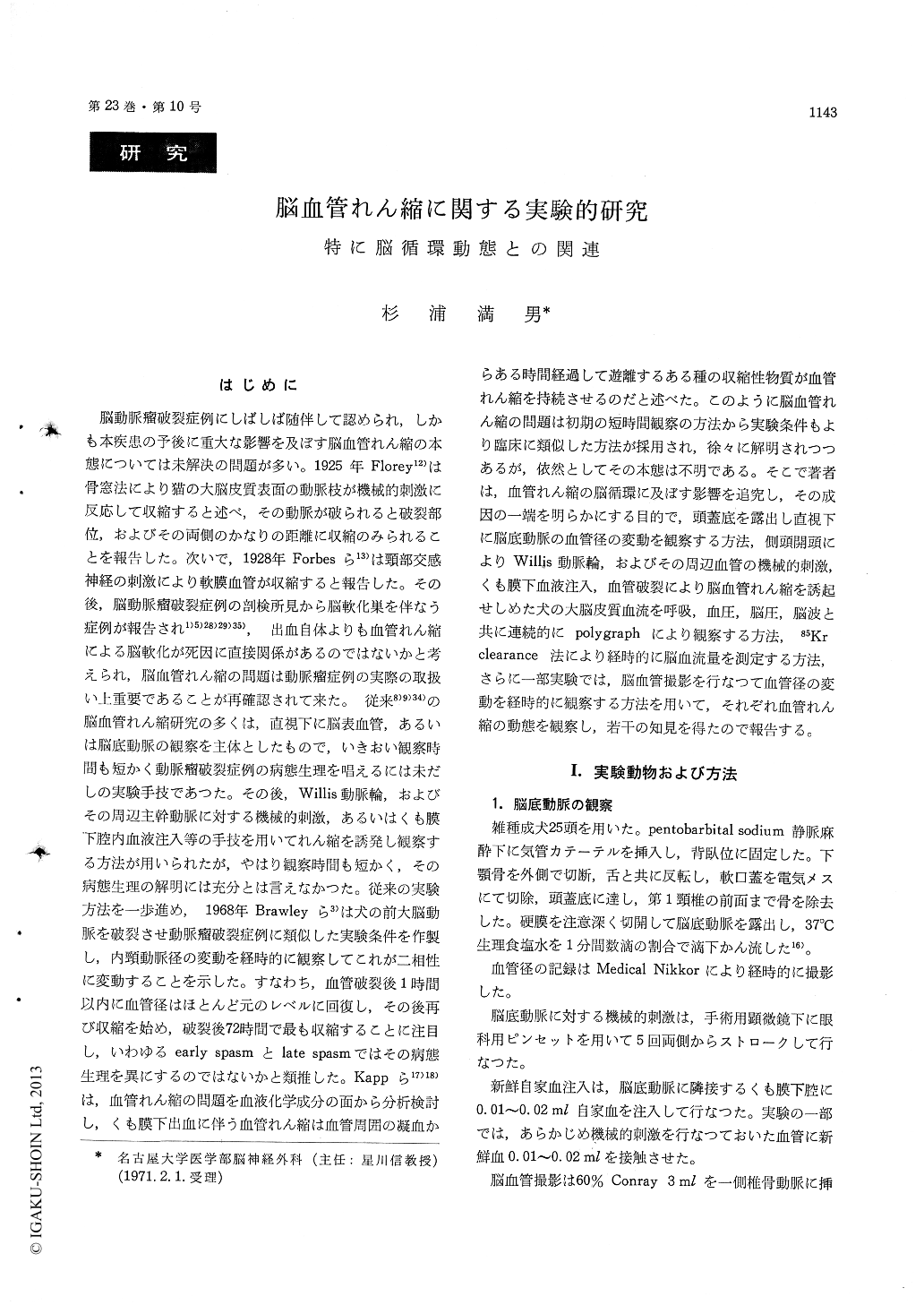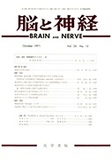Japanese
English
- 有料閲覧
- Abstract 文献概要
- 1ページ目 Look Inside
はじめに
脳動脈瘤破裂症例にしばしば随伴して認められ,しかも本疾患の予後に重大な影響を及ぼす脳血管れん縮の本態については未解決の問題が多い。1925年Florey12)は骨窓法により猫の大脳皮質表面の動脈枝が機械的刺激に反応して収縮すると述べ,その動脈が破られると破裂部位,およびその両側のかなりの距離に収縮のみられることを報告した。次いで,1928年Forbesら13)は頸部交感神経の刺激により軟膜血管が収縮すると報告した。その後,脳動脈瘤破裂症例の剖検所見から脳軟化巣を伴なう症例が報告され1)5)28)29)35),出血自体よりも血管れん縮による脳軟化が死因に直接関係があるのではないかと考えられ,脳血管れん縮の問題は動脈瘤症例の実際の取扱い上重要であることが再確認されて来た。従来8)9)34)の脳血管れん縮研究の多くは,直視下に脳表血管,あるいは脳底動脈の観察を主体としたもので,いきおい観察時間も短かく動脈瘤破裂症例の病態生理を唱えるには未だしの実験手技であった。その後,Willis動脈輪,およびその周辺主幹動脈に対する機械的刺激,あるいはくも膜下腔内血液注入等の手技を用いてれん縮を誘発し観察する方法が用いられたが,やはり観察時間も短かく,その病態生理の解明には充分とは言えなかつた。従来の実験方法を一歩進め,1968年Brawleyら3)は犬の前大脳動脈を破裂させ動脈瘤破裂症例に類似した実験条件を作製し,内頸動脈径の変動を経時的に観察してこれが二相性に変動することを示した。すなわち,血管破裂後1時間以内に血管径はほとんど元のレベルに回復し,その後再び収縮を始め,破裂後72時間で最も収縮することに注目し,いわゆるearly spasmとlate spasmではその病態生理を異にするのではないかと類推した。Kappら17)18)は,血管れん縮の問題を血液化学成分の面から分析検討し,くも膜下出血に伴う血管れん縮は血管周囲の凝血からある時間経過して遊離するある種の収縮性物質が血管れん縮を持続させるのだと述べた。このように脳血管れん縮の問題は初期の短時間観察の方法から実験条件もより臨床に類似した方法が採用され,徐々に解明されつつあるが,依然としてその本態は不明である。そこで著者は,血管れん縮の脳循環に及ぼす影響を追究し,その成因の一端を明らかにする目的で,頭蓋底を露出し直視下に脳底動脈の血管径の変動を観察する方法,側頭開頭によりWinis動脈輪,およびその周辺血管の機械的刺激くも膜下血液注入,血管破裂により脳血管れん縮を誘起せしめた犬の大脳皮質血流を呼吸,血圧,脳圧,脳波と共に連続的にpolygraphにより観察する方法,85Krclearance法により経時的に脳血流量を測定する方法,さらに一部実験では,脳血管撮影を行なつて血管径の変動を経時的に観察する方法を用いて,それぞれ血管れん縮の動態を観察し,若干の知見を得たので報告する。
Serial changes in CBF as well as vital signs following traction or rupture of the posterior communicating artery and blood infusion into the subarachnoid space were observed in dogs.
Following traction of the artery, decrease in CBF was observed for about 20 min. Following blood infusion into the cisterna magna, CBF decreased for 60 to 150 min. Further observation did not show any change.
Following rupture of the artery, CBF decreased and then returned to the base line within 60 to 150 min. After this restoration, CBF revealed a tendency to decrease gradually with the lapse of time. Such a biphasic change in CBF following rupture of the posterior communicating artery might mean that the mechanism lowering CBF in the acute phase of spasm differs from that in the chronic phase. In the acute phase the mechanical traction, fresh blood in the subarachnoid space and increased intracranial pressure might act as the factor producing the vasospasm which lasted for 60 to 150 min. In the chronic phase two etiologic factors might be considered. One is a substance requiring one day or more time to act as a vaso-constrictor, and the other is changes in vasoreacti-vity due to damage of the vessel wall.
When the basilar artery was punctured with a fine needle, spasm observed only at the site of puncture. When blood reached to the circle of Willis through the subarachnoid space, it was veri-fied by cerebral angiography that the whole vas-cular system at the basis constricted markedly.

Copyright © 1971, Igaku-Shoin Ltd. All rights reserved.


